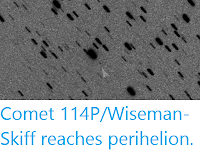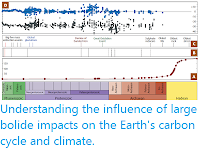Asteroid 2020 AN3 passed by the Earth at a distance of about 3 045 800
km (7.93 times the average distance between the Earth and the Moon, or 2.04% of the distance between the Earth and the Sun), at about 1.35 am
GMT on Friday 17 January 2020. There was no danger of
the asteroid hitting us, though were it to do so it would have
presented a considerable threat. 2020 AN3 has an estimated
equivalent
diameter of 160-500 m (i.e. it is estimated that a spherical object with
the same volume would be 160-500 m in diameter), and an object of this
size would be predicted to be capable of passing through the Earth's
atmosphere relatively intact, impacting the ground directly with an
explosion that would be 10 000-300 000 times as powerful as the
Hiroshima
bomb. Such an impact would result in an impact crater 2.5-8 km in diameter
and devastation on a global scale, as well as climatic effects that
would last decades or even centuries.
180 second image of 2020 AN3 taken with the Elena Planetwave 17" Telescope at Ceccano
in Italy on 16 January 2020. The asteroid is the small point at the
centre of the image, the longer lines are stars, their elongation being
caused by the telescope tracking the asteroid over the length of the
exposure. Gianluca Masi/Virtual Telescope.
2020 AN3 was discovered on 14 January 2020 (three days before its closest approach to the Earth) by the University of Arizona's Catalina Sky Survey,
which is located in the Catalina Mountains north of Tucson. The
designation 2020 AN3 implies that it was the 85th asteroid (object N3 -
in numbering asteroids the letters A-Y, excluding I, are assigned
numbers from 1 to 24, so that N3 = (24 x 3) + 13 = 85)
discovered in the first half of January 2020 (period 2020 A).
The calculated orbit of 2020 AN3. Minor Planet Center.
2020 AN3 has an 1158 day (3.17 year) orbital period and an eccentric orbit
tilted at an angle of 26.3° to the plane of the Solar System, which
takes it from 0.97 AU from the Sun (i.e. 97% of the the average distance
at
which the Earth orbits the Sun) to 3.35 AU from the Sun (i.e. 335% of
the
average distance at which the Earth orbits the Sun, and more than twice as distant from the Sun as the planet Mars). It is therefore
classed as an
Apollo Group Asteroid (an asteroid that is on average further from the
Sun than the Earth, but which does get closer). This means that close
encounters between the asteroid and Earth are extremely common, with the
last having occurred in January 2001 and the next predicted
in December 2035. As an
asteroid probably larger than 150 m in diameter
that occasionally comes within 0.05 AU of the Earth, 2019 AV2 is also
classified as a Potentially Hazardous Asteroid.
See also...
Follow Sciency Thoughts on Facebook.








